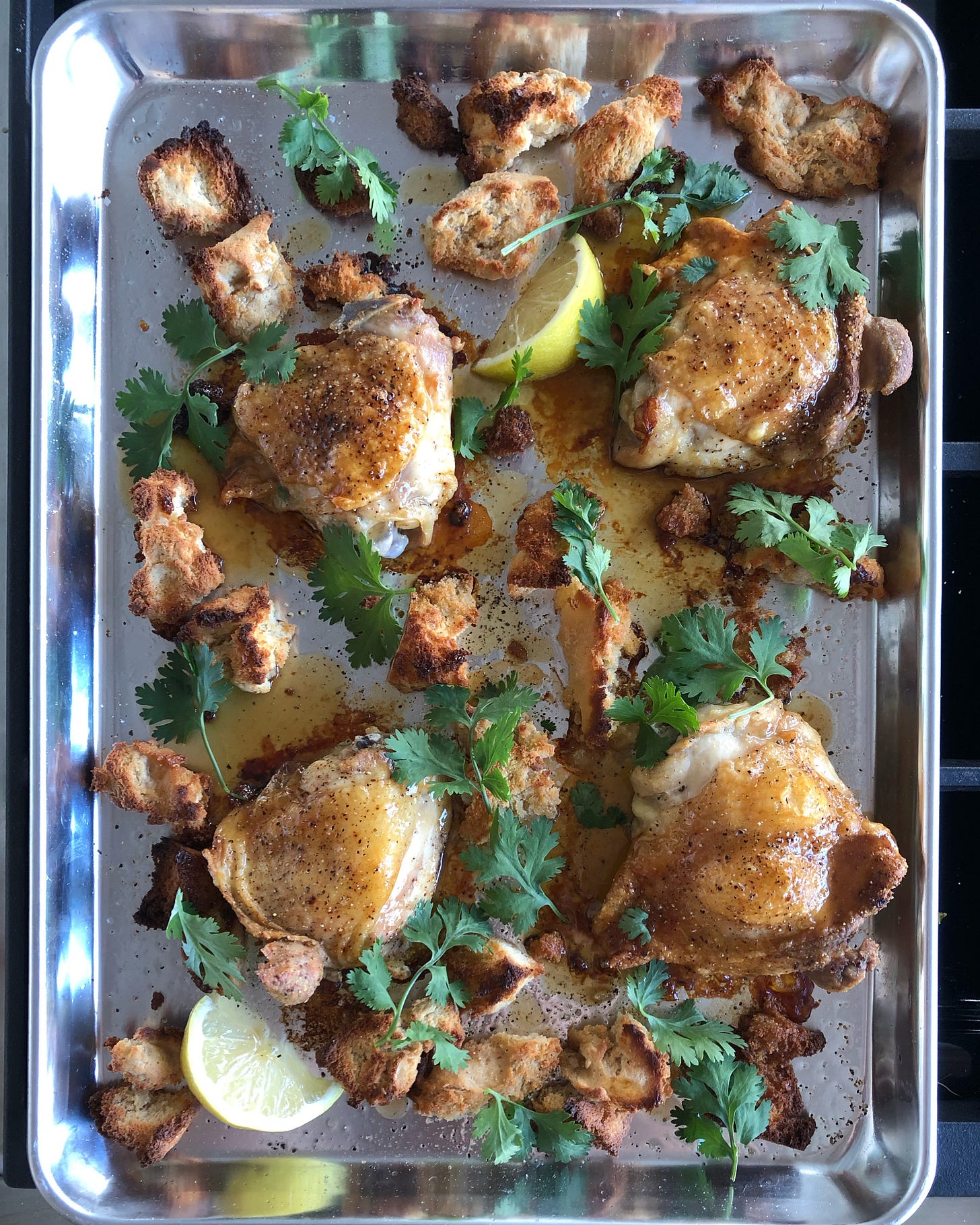That One Dish Spotlight, No. 7: Eric Kim [From the Archives]
A blast from the past with cookbook author and writer for the NYT food desk, Eric Kim on a uniquely Korean-American chicken dish
**Just as a heads up: some of the links in this post are affiliate links, meaning I’ll earn a small commission at no extra cost to you if you decide to purchase the amazing books, ingredients, etc. through them. Thank you ever so much in advance for your support of this newsletter ❤️
The that one dish. spotlight is a column that connects us with amazing AAPI writers, artists, chefs, creators, and entrepreneurs who talk about the “one dish” that best captures their experiences living at the intersection of multiple cultures. Everyone’s got “that one dish” that provokes a certain emotion, becomes a staple they lean on in the ups and downs of life, or immediately transports them to a formative time, Anton Ego-style. Our personal experiences continue to show how food and the five senses involved with both making and enjoying it evoke vivid memories that serve as meaningful links to the past. You can check out TOD’s archive of past interviews here.
Hi all, I hope everyone’s doing well—and happy first day of AAPI Heritage Month! Apologies that there was no dispatch last Wednesday; I took a very spontaneous (read: I made my decision to go seven hours before the plane departed) trip to London last week and was, for the most part, offline. The last few days involved tucking into flaky croissants and a full English fry-up at The Wolesley, urban sketching around Westminster, getting lost in Fortnum and Mason, and enjoying a thoroughly satisfying meal of black pork kari, hoppers, and string hoppers. I’m still in recovery mode; jet lag might be a choice for Taylor Swift, but it definitely ain’t the case with me.
With that said: this week I’m keeping it low-key and bringing back a conversation I had a couple years ago with the one and only, Eric Kim, for a previous iteration of this “That One Dish” segment—way before the release of the bestselling “Korean-American,” his debut cookbook in which he explored both his upbringing as the son of two Korean immigrants and multicultural identity through food and cooking. Food has always been central to Eric’s story, no doubt about it. I’d had the privilege of speaking with him about this recipe for roasted chicken with croutons and fish sauce butter—one dish that, to him, has become the pinnacle of his experience growing up Korean-American. Though chicken and bread may not scream “Korean-American” off the bat, the Three Crabs fish sauce used to flavor the sauce is a beloved pantry staple for many Korean immigrants in America and continues to be a main ingredient in much of the food Eric makes today. (But, I’ll step back and let him tell that story). Considering that New York Times Cooking reminded us on Instagram this past weekend about the subtle joys of crispy-skinned chicken thighs with schmaltzy croutons drizzled with a buttery, flavor-packed pan sauce, I thought now was an appropriate time to bring this gem back to your inboxes—especially for those who are new here 😉.
You can find the recipe for Eric’s roasted chicken with fish sauce butter here, as well as many more in “Korean-American.” Thanks again, everyone, for letting me share this throwback. Have a wonderful rest of the week!
Note: this interview was originally conducted in 2021.
What's one dish that captures who you are as a Korean-American? Something that best encompasses your life, your experiences, your existence—without thinking of what's authentic, what dish is the most "you?"
I love this detail: "without thinking of what's authentic." Thank you for asking that question so thoughtfully. Writing my cookbook, I have, of course, spent many nights thinking about what it means to be just that and what it might look like on a plate. Each time I felt that I had landed on some semblance of a definition for it, something would contradict it completely. I think this is because a) no culture is a monolith, obviously; and b) even if there were a collective understanding of what it means to be "Korean-American," that hive mind would mutate into something else entirely next week.
But if I were to pick a dish—for me, and truly just for me—it would be something like this roasted chicken with croutons and fish-sauce butter, or some other protein with a quick pan sauce, emulsified with butter 9/10 times. It's the kind of thing I cooked for myself when I was younger and was just starting to find my footing in the kitchen. Nothing about that dish, chicken and bread, reads Korean American off the bat, culinarily anyway, though I could tell you about growing up with myeolchi aekjeot, or anchovy sauce, and how my mother and many other Korean immigrants in America use Three Crabs fish sauce even though it's Vietnamese; and how jeotgal, or salted seafood, is a vast category and primary flavoring in Korean home cooking and thus finds its way as a main ingredient in a lot of my food today, from that fish-sauce butter pan sauce to this kimchi jjigae—and so on and so forth. But what I really think is: we are a culmination of our experiences. That chicken dish captures who I am as a Korean-American because I am a Korean-American who cooks it and eats it.
How do you make it?
It's a very simple dish and, if I'm being honest, pretty lazy (which says a lot about who I am as a cook). I think that's why I'm so fond of it: Some people think I cook the most elaborate meals in my personal life, but this is actually the kind of food I make for myself at the end of the day. To make it, you roast bone-in, skin-on chicken thighs on a sheet pan in the oven, and halfway through, toss in some hand-torn milk bread (usually homemade, yum), which crisp up into sweet, crispy-chewy croutons. (Crispy-chewy is the best texture, by the way.) The dish is rich and schmaltzy, and if I'm alone, it's likely I've already ripped the skins off of all four chicken thighs and made that my meal for night one. I can eat the actual chicken any other time. What's most magical about this kind of dinner, though, is the pan sauce, made with fish sauce, lemon juice, brown sugar, and butter. I love pan sauces because they teach three basic cooking techniques that will stay with you forever: deglazing, reducing, and emulsifying. Deglazing a pan means you're picking up all the browned bits with liquid after searing food, especially meat, thereby making dishes easier later. Reducing means you're concentrating the volume (and thus, flavor) of whatever that deglazing liquid was, which, contrary to popular belief, does not always have to be stock or wine; it can be whatever flavorful ingredients bedeck your pantry (like fish sauce). Emulsifying means you're slowly incorporating fat, in this case butter, into that flavorful, reduced, and now syrupy, liquid, creating a velvety pan sauce that coats meat, vegetables, what have you with glossy wonder. I learned all these techniques by watching Food Network after school when I was younger.
When you do eat it, what feelings does it bring to you? What makes that dish special in your mind, and what specific memories do you have associated with it?
If I were to pick a word to describe what this dish makes me feel, it'd be: self-sufficient. When I was little, my mother, like many Asian parents, rarely used the oven. It was storage for bulky pots and pans, in the way that the dishwasher is a drying rack, you know? So I had never even tasted a roast chicken until I made one myself after seeing it a few times on TV. I must've been like, 13 years old. That's when I really got into cooking, when I realized that I could, by my own hands, learn and grow and experience brand new tastes; even more, I could introduce those flavors to my family. I could introduce them to new cuts of meat, too. We never ate bone-in, skin-on chicken thighs until I brought them home from the store. And I'm so glad I did: They're the best parts of a whole roast chicken, in my opinion. You get the crispy skin and the juicy meat, and bones that are more manageable to eat around—not to mention they cook faster and there's no carving involved. It's a powerful thing, self-sufficiency.
I was filming the video for this recipe and got emotional when I stared down at the finished dish. My producer was like, "What's happening." I know that sounds so sappy, but this chicken makes me think about everything it took to get here, all the ups and downs that brought me to where I am now in my career, in my cooking identity, and in my life as a food writer. It feels like a fresh start, a debut of sorts, and yet that recipe (and its pan sauce) also represents for me the culmination of all the chicken dinners I've ever made, whether publicly or privately. It's exactly what I would serve to a friend, a family member, a coworker, a lover, an enemy. As a recipe developer, I've always felt that chicken dishes are especially hard to develop because they're so ubiquitous. Does the world need another chicken recipe? Probably not. But this one was in me, and it's out in the world and on people's plates. And that makes me so happy.
Is it something you'd serve Timothée Chalamet?
Let's be clear: I would serve anything to Timothée Chalamet. Anything Timmy wants, Timmy gets. Though, funnily enough, a reader pointed out to me recently that I actually did feed him an earlier version of this dish in one of my fan fiction posts. In my memory, he gobbled it up.






